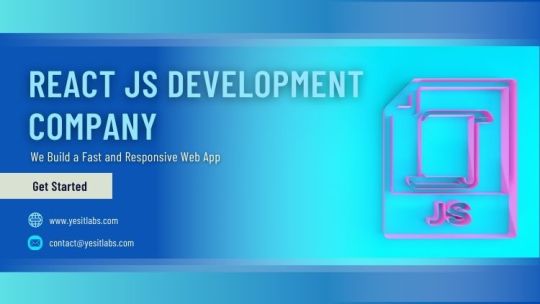#react js development company
Text
Next JS vs React: Which Framework to Choose for Optimal Frontend in 2024.

Read more Blogs,
Visit Website, Glasier Inc.
ReactJS development company
Hire Reactjs developers
Hire SaaS developers
Hire Android app developers
Hire IOS developers
#react js vs next js#next vs react#hire react js developers#hire dedicated developers#hire android developers#hire ios developers#react js development company#mobile app development company#ios app development services#custom software development company#custom software development
2 notes
·
View notes
Text
#react Js development company#react developer#hire dedicated react JS developer#hire reactjs developer
0 notes
Text

React js Web Development Company
Elevate your web presence with IBR Infotech, a leading ReactJS development company specializing in cutting-edge web solutions. Our expert team leverages the power of ReactJS to create stunning, high-performance websites and applications that captivate audiences and drive results. As a trusted ReactJS development service provider, we offer tailor-made solutions to suit your unique needs, from dynamic UI/UX design to seamless backend integration. Partner with IBR Infotech, the premier React development company, and unlock the full potential of your digital platform. Experience innovation, reliability, and excellence with our React development services. Contact us today to transform your vision into reality.
#react development company#reactjs development service#react js development company#react development services
0 notes
Text
Top benefits of choosing Raghwendra Web Services, the top-notch react JS development company in India for your project.
#react js development company#next js developers#next js development services#Hire Next js developer
0 notes
Text
Intellisense Technology is a leading React.js development company, known for crafting dynamic and interactive web applications. With a focus on React.js's component-based architecture and virtual DOM, Intellisense builds scalable and responsive solutions tailored to clients' needs. Their expertise ensures efficient development, seamless integration, and exceptional user experiences.
0 notes
Text
Cypress E2E Testing With React.js: Streamlining Your Testing Workflow Like a JavaScript Ninja
Navigating the intricate landscape of web development, the integration of Cypress E2E testing with React.js stands out as a powerful alliance for enhancing code quality and refining development processes. As React.js becomes the cornerstone for building modern user interfaces, the seamless compatibility with Cypress provides a compelling testing environment. Whether you're considering hiring a React.js developer or engaging a React.js development company, the synergy of these technologies offers a robust solution for end-to-end testing. This blog post will guide you through the setup process, showcasing best practices in writing Cypress tests for React components, addressing asynchronous operations, and seamlessly integrating Cypress into your continuous integration pipeline. By exploring advanced techniques and considerations for hiring React.js developers or collaborating with React.js development companies, you'll unlock the full potential of this dynamic pairing, streamlining your testing workflow and elevating the overall quality of your React.js applications.

Why Cypress? It's More Than Just a Tool, It's a Testing Experience:
Speed Demon: Unlike its sluggish competitors, Cypress runs tests directly within the browser, eliminating the need for separate test runners and shaving precious seconds (or even minutes) off your testing time.
Visualize Your Victory: Forget cryptic logs and confusing errors. Cypress boasts a beautiful, intuitive test runner that displays real-time test execution, screenshots, and detailed logs, making debugging a breeze.
Wait, You Said Automatic? Gone are the days of manually waiting for elements to load. Cypress handles asynchronous operations like a boss, automatically waiting for elements to be visible or actions to complete before proceeding.
Built for the Modern Web: Designed with modern web development in mind, Cypress seamlessly integrates with DevTools, allowing you to leverage your existing debugging skills right within the test runner.
Data-Driven Dynamo: Test different scenarios with ease using data-driven testing, ensuring your application works flawlessly under various conditions.
React.js and Cypress: A Synergy Made in JavaScript Heaven:
Built with JavaScript in Mind: Both React and Cypress share a foundation in JavaScript, making them naturally compatible. Write clear, readable tests that seamlessly interact with your React components.
Component-Level Granularity: Need to test individual React components in isolation? Cypress plays nice with React Testing Library, allowing you to focus on component behavior without relying on implementation details.
Seamless Integration: With tools like Cypress React DevTools, you can easily inspect and interact with your React application state directly from the test runner, streamlining the debugging process.
Streamlining Your Workflow: Tips for the Testing Ninja:
Start Small and Scale Up: Begin by testing key user flows and gradually expand your test coverage as your application evolves.
Organize Your Tests: Use clear naming conventions and group related tests for better maintainability and easier navigation.
Embrace Data-Driven Testing: Define reusable datasets to efficiently test multiple scenarios and edge cases.
Leverage Fixtures: Store common test data or API responses in fixtures to avoid code duplication and simplify test setup.
Record and Replay: Save time and effort by recording user interactions and replaying them as automated tests.
Integrate with CI/CD: Automate your testing pipeline by integrating Cypress with continuous integration and continuous delivery (CI/CD) tools.
Unleash the Testing Ninja Within:
By embracing Cypress and its synergy with React.js, you can transform your E2E testing workflow from a chore into a streamlined, efficient, and even enjoyable experience. So, grab your metaphorical shurikens and mask, channel your inner testing ninja, and start writing tests that would make even the most seasoned developer proud. Remember, with Cypress and React.js on your side, the path to a flawlessly tested application is yours to conquer
Frequently Asked Questions about Cypress E2E Testing with React.js:
General:
What is Cypress E2E testing? Cypress is an end-to-end testing framework specifically designed for modern web applications. It performs real browser actions, making it ideal for testing React.js apps.
Why use Cypress for React.js? Cypress offers several advantages for React testing:
Built for asynchronous apps: Cypress understands React's asynchronous nature, eliminating flaky tests due to timing issues.
Visual diffs for debugging: See exactly what changed after a test failure, making debugging faster and easier.
Developer-friendly API: The API feels natural to React developers, reducing the learning curve.
What are the benefits of using Cypress with React.js?
Reduced costs: Catching bugs early saves time and money on fixing them in production.
Improved quality: Deliver a polished, bug-free app that keeps users happy.
Faster development: Streamlined testing means quicker iterations and faster updates.
Technical:
How do I set up Cypress with React.js? Setting up Cypress is straightforward. You can find detailed instructions in the official documentation: https://docs.cypress.io/guides/overview/why-cypress
What type of tests can I write with Cypress? Cypress supports various test types, including unit, integration, and end-to-end tests.
How do I handle asynchronous actions in my tests? Cypress automatically waits for elements to load before interacting with them, simplifying test writing.
How do I debug failures in Cypress? The intuitive test runner allows you to replay tests step-by-step and pinpoint the exact issue.
Can I integrate Cypress with my CI/CD pipeline? Absolutely! Cypress seamlessly integrates with popular CI/CD tools for automated testing.
Hiring and Expertise:
Do I need to hire a React.js development company for Cypress testing? If you have an in-house development team comfortable with testing and Cypress, you can handle it yourselves. However, hiring a company with expertise in both React and Cypress testing can offer several benefits:
Proven track record and experience: They've built high-quality apps and know how to test them effectively.
Faster adoption and implementation: They can help you set up and integrate Cypress efficiently.
Ongoing support and guidance: They can provide ongoing support and answer your questions as you navigate Cypress testing.
Bonus:
Where can I find more resources on Cypress E2E testing with React.js? The official Cypress documentation is a great starting point: https://docs.cypress.io/guides/overview/why-cypress. Additionally, you can find tutorials, articles, and community forums online.
0 notes
Text
#benefits of React JS#front-end web development with React#front-end frameworks#hire dedicated React developers#React JS development company#React JS
0 notes
Text
Top-Notch ReactJs Development Company In the USA
TechEniac is a highly regarded ReactJS development company in the USA based in India specializing in scalable web app development, with a team of expert developers who create dynamic, compelling web apps customized to meet clients' unique business needs.
1 note
·
View note
Text
Trusted React JS Development Company in Ahmedabad - 5Mindz Technolabs
Partner with a trusted ReactJS development company in India, 5Mindz Technolabs, known for offering exclusive ReactJS development services to startups, SMEs, and enterprises worldwide. Our expertise aids in constructing solid, scalable, and forward-thinking applications that foster global growth and success.
1 note
·
View note
Text

How a React JS Development Company Can Help You Build a Fast and Responsive Web App
Maximize the potential of your web app through our React JS Development Company. Improve speed, responsiveness, and user experiences. Uncover possibilities today
#React JS Development Company#reactjs web development company#hire react js expert#reactjs developers for hire
0 notes
Text
Reytech Infoways: Crafting Digital Excellence for Your Business
In the rapidly evolving digital landscape, a strong online presence is the cornerstone of success for businesses across industries. At Reytech Infoways, we take pride in being the architects of digital excellence, dedicated to delivering cutting-edge web development solutions that elevate your brand and drive results.
Our Commitment to Tailored Solutions
Recognizing the uniqueness of every business, Reytech Infoways is committed to providing tailored web development solutions that align with your specific needs and goals. Whether you're a startup aiming for a powerful market entry or an established enterprise seeking a digital transformation, our team of seasoned developers is equipped to turn your vision into a compelling online reality.
Embracing the Latest Technologies for Future-Ready Websites
In a landscape where technology evolves rapidly, staying ahead is not a choice but a necessity. Reytech Infoways prides itself on its proactive approach to adopting the latest technologies and frameworks. From responsive design to progressive web apps, we leverage state-of-the-art tools to ensure that your website not only meets today's standards but is also poised to adapt to future innovations.
User-Centric Design for Immersive Experiences
Beyond aesthetics, we understand the critical importance of user experience. Our development process prioritizes creating intuitive and seamless interfaces, fostering an immersive journey for your visitors. A user-centric design approach is at the core of our philosophy, ensuring that your audience remains engaged from the first interaction to conversion.
Performance Optimization: Speed and Reliability
In the fast-paced digital world, speed is of the essence. Reytech Infoways places a strong emphasis on performance optimization to ensure that your website not only looks impressive but loads swiftly and operates efficiently. This commitment to speed and reliability contributes not only to a positive user experience but also to bolstering your search engine rankings.
Security: Safeguarding Your Digital Assets
The security of your website and the sensitive data it handles is our top priority. Reytech Infoways implements robust security measures, including SSL encryption, secure coding practices, and regular audits, to provide a secure digital environment for your business and your customers.
Seamless Integration and Scalability
As your business evolves, so should your digital presence. Reytech Infoways' web development services are designed with scalability in mind, allowing for seamless integration of new features and functionalities. Whether it's e-commerce capabilities, third-party integrations, or custom plugins, we ensure that your website remains a dynamic and powerful asset.
Collaboration and Transparent Communication
At Reytech Infoways, we believe in the power of collaboration. Throughout the development process, we maintain open lines of communication, ensuring that you are informed and involved at every stage. Your feedback is not only valued but is integral to the success of the project.
Embark on a Journey of Digital Excellence with Reytech Infoways
Your business deserves a web development partner that understands your aspirations and has the expertise to turn them into reality. Reytech Infoways invites you to embark on a journey of digital excellence. Contact us today, and let's build something extraordinary together – a website that not only meets the demands of today but anticipates the challenges of tomorrow.
#web development#web developers#web developing company#app development#app developers#android developer#ios development#flutter app development#react native app development company#java developers#angular development services#java script#magento development#node js development company#php development#react js development company#vue js development#wordpress development#blockchain development#devops development company#django development#python development
1 note
·
View note
Text
Top React Js Development Company
Reytech Infoways is a prominent provider of high-performance and enduring mobile app development solutions and services, specialized in ReactJS. Their extensive offerings contain native Android app development, native iOS app development, and cross-platform app growth. Throughout every step of the Android app development procedure, Reytech Infoways reveals profound expertise.
0 notes
Text
How To Create A Login Page In ReactJs - An Ultimate Guide
Websites have both public and private pages. A public page is available to anybody, but a private page requires a user login. Authentication can be used to control which users have access to which pages. When a user attempts to view a private page before logging in, our React application must handle it. We'll need to save the login credentials once they've properly authenticated.
We'll create a dummy API that returns a user token, a login page that retrieves the token and an authentication check that doesn't reroute the user. If a user is not authenticated, we will prompt them to check in before enabling them to progress without requiring them to visit a separate login page.
What Is ReactJS?
ReactJS is an open-source JavaScript library used for building user interfaces or UI components. It is maintained by Facebook and a community of individual developers and companies. React is often employed for creating single-page applications where data can change over time without requiring a full page refresh.
Key characteristics and features of ReactJS include:
Component-Based Architecture:
React follows a component-based approach, where the UI is divided into reusable, self-contained components. Each component encapsulates its own functionality, state and rendering logic, making it easier to build and maintain complex UIs.
Declarative:
React allows developers to describe the desired state of a UI and it automatically manages the updates when the underlying data changes. This leads to more predictable code.
Virtual DOM (Document Object Model):
React utilizes a virtual representation of the DOM, called the Virtual DOM. It creates a lightweight copy of the actual DOM, allowing React to efficiently update and render only the necessary components when there are changes. This approach results in improved performance and faster UI updates.
JSX (JavaScript XML):
React uses JSX, which is an extension to JavaScript. JSX allows developers to write HTML-like syntax within JavaScript code, making it easier to describe the structure and appearance of UI components. JSX is then transpiled into regular JavaScript by build tools like Babel.
Unidirectional Data Flow:
React follows a unidirectional data flow, which means data in a React application flows in a single direction, from parent components down to child components. This makes it easier to track and manage the state of your application.
Declarative Syntax:
React promotes a declarative approach to building UIs. Developers describe what the UI should look like based on the current state and React takes care of updating the actual UI to match the desired state. This declarative syntax allows for more straightforward code and reduces the risk of bugs caused by manual DOM manipulation.
React Ecosystem:
React has a vast ecosystem of libraries, tools and community support. It integrates well with other libraries and frameworks, such as React Router for routing, Redux for state management and Axios for handling HTTP requests. This rich ecosystem enables developers to extend React's capabilities and build robust applications.
Add The Container:
To add a container to your React application, you can create a new component that serves as a wrapper for your content. This container can help with layout and styling and it's a common practice in web development.
Let's assume you want to add a container around your `Login` component from the previous example. Here's how you can do it:
1. Create A Container Component:
In the `src` folder, create a new component named `Container.js`:
// src/Container.js
import React from 'react';
const Container = ({ children }) => {
return
{children}
;
};
export default Container;
```
In this example, the `Container` component is a simple wrapper that takes `children` as a prop and renders them inside a `
` element with a class of "container".
2. Use the Container Component in Your App:
In your `App.js`, import the `Container` component and wrap it around your `Login` component:
// src/App.js
import React from 'react';
import { BrowserRouter as Router, Route, Switch } from 'react-router-dom';
import Container from './Container'; // Import the Container component
import Login from './Login';
const App = () => {
return (
{/* Render the Login component inside the Container */}
{/* Add other routes here */}
);
};
3. Add CSS for the Container:
You can create a CSS file to style the container. Create a new file named `Container.css` inside the `src` folder:
/ src/Container.css /
.container {
max-width: 800px;
margin: 0 auto;
padding: 20px;
}
This CSS will give your container a maximum width of 800 pixels, center it on the page and provide some padding around the content.
4. Import the CSS in Your App :
In your `App.js`, import the CSS file:
// src/App.js
import React from 'react';
import { BrowserRouter as Router, Route, Switch } from 'react-router-dom';
import Container from './Container';
import Login from './Login';
import './Container.css'; // Import the CSS file
const App = () => {
return (
{/ Add other routes here /}
);
};
Add the Route
To add a route to your React application, you can use the `react-router-dom` library. This allows you to navigate between different pages or components based on the URL.
Assuming you want to add a route to a hypothetical dashboard page, follow these steps:
1. Create a Dashboard Component :
In the `src` folder, create a new component named `Dashboard.js`:
// src/Dashboard.js
import React from 'react';
const Dashboard = () => {
return
Welcome to the Dashboard!
;
};
2. Update App.js with the New Route :
In your `App.js`, import the necessary components and create a new `Route` for the `Dashboard`:
// src/App.js
import React from 'react';
import { BrowserRouter as Router, Route, Switch } from 'react-router-dom';
import Container from './Container';
import Login from './Login';
import Dashboard from './Dashboard'; // Import the Dashboard component
import './Container.css';
const App = () => {
return (
{/* Add a new Route */}
);
};
In this example, we've added a new `Route` with the path `/dashboard`, which renders the `Dashboard` component.
3. Update Navigation :
If you want to navigate to the dashboard, you'll need a link. You can create a link in your `Login` component:
// src/Login.js
// Import the necessary components
import React, { useState } from 'react';
import { Link } from 'react-router-dom';
const Login = () => {
// ...existing code...
return (
Login
{/* ...existing form inputs... */}
Login
Go to Dashboard {/* Add this link */}
);
};
The `Link` component from `react-router-dom` is used to create a link to the dashboard page.
4. Test the Application :
Start your React application and navigate to the login page. You should see a "Go to Dashboard" link. Clicking on it will take you to the dashboard page.
Prerequisites
Before you start working with ReactJS, it's important to have a basic understanding of certain web development technologies. Here are the key prerequisites you should be familiar with:
HTML/CSS: You should have a good grasp of HTML (HyperText Markup Language) for creating the structure of web pages and CSS (Cascading Style Sheets) for styling those pages.
JavaScript (ES6+): React is a JavaScript library, so a solid understanding of JavaScript is essential. Familiarize yourself with ES6+ features like arrow functions, destructuring, classes and modules.
Node.js and npm (Node Package Manager): React projects are typically managed with Node.js and npm. Make sure you have Node.js installed on your machine. You can download it from the official website: [Node.js](https://nodejs.org/). npm is included with Node.js.
Basic Command Line/Shell Usage: You'll need to be comfortable navigating and running commands in your terminal or command prompt.
Text Editor or IDE: Choose a text editor or Integrated Development Environment (IDE) for writing your code. Popular choices include Visual Studio Code, Sublime Text, Atom and others.
Basic Knowledge of JavaScript Frameworks/Libraries: While not strictly necessary, having some experience with other JavaScript libraries or frameworks (like Angular, Vue.js, or jQuery) can give you context for understanding React's approach to building user interfaces.
Conclusion:
In conclusion, ReactJS is a powerful JavaScript library for building dynamic and interactive user interfaces. Its component-based architecture, virtual DOM and efficient rendering make it a popular choice for web development projects.
TAGS: How To Create A Login Page In ReactJs - An Ultimate Guide, Looking for React Js Development Service, Connect Infosoft, Looking for React Js Development Company, Looking for React Js Developers, React Js Developers Team, React Js Developers Team in India
#reactjs#reactjs development company#reactjs developers#reactjs development services#react js development company#react js#react js development services#react js developers
1 note
·
View note
Text
Raghwendra Web Services explain how to choose the best react JS development company and next JS developers for next JS development services in 2024.
#react js development company#next js developers#next js development services#Hire Next js developer
0 notes
Text

Elevate Your Web Experience with TGSANE's Expert React JS Development Services
Discover unparalleled excellence in web development with TGSANE Technologies, your trusted React Development Company. Our seasoned experts harness the power of React JS to craft seamless, lightning-fast web applications that captivate and engage. Elevate your online presence today with our tailored React JS Development Services. Experience the TGSANE advantage!
0 notes
Text
How to Choose the Right React JS Development Company
Discover the key factors in selecting the right React JS development company for your project. Our guide provides insights into evaluating expertise, experience, and reliability to ensure your ReactJS development needs are met seamlessly. Make an informed decision with tips on assessing portfolios, client testimonials, and development methodologies. For the best React JS development services, call us at +1 (315) 210-8382.
#React JS development services#React JS development#React JS development company#ReactJS development company#ReactJS development services
0 notes